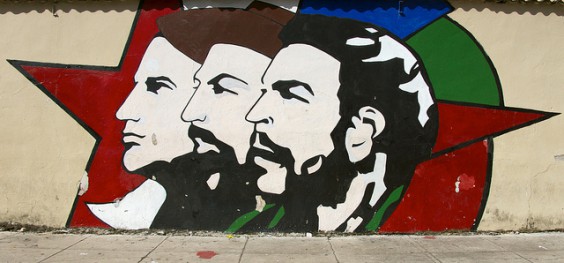Santo Domingo de La Habana, the Cinematographic Capital of the Domini-Cuban Republic
by Orlando Luis Pardo Lazo translated by Alex Higson / March 31, 2015 / No comments

A mural in Havana. Parts of Santo Domingo will need to be transformed to resemble the capital of Cuba. Photo via Flickr user: Ed Yourdon.
Because Cuban authorities treat Havana like their private property, a film set in the city will be filmed in neighboring Santo Domingo.
Over the next few weeks the city of Santo Domingo will take on the role of Cuba’s capital city, despite still being situated on a neighboring Caribbean island. It is stepping up to the plate for the movie adaptation of Pedro Juan Gutiérrez’s El Rey de La Habana (The King of Havana) — one of contemporary Cuban literature’s most heartbreakingly important books — which started filming in the Dominican Republic in mid-March.

- Is it worth-while to focus on the last images and letters coming from the inside of the last living utopia on Earth? Is Cuba by now a contemporary country or just another old-fashioned delusion in the middle of Nowhere-America? A Cold-War Northtalgia maybe? Can we expect a young Rewwwolution.cu within that Ancien Régime still known as The Revolution? I would like to provoke more questions than answers.

- Orlando Luis Pardo Lazo was born in Havana City and still resides and resists there, working as a free-lance writer, photographer and blogger. He is the author of Boring Home (2009) and is the editor of the independent opinion and literary e-zine Voces.
There were no two ways about it. On the Island of the Revolution, any work this important would be censored before it could be made. As the Maximum Leader’s political slogans put it, it comes down to “the fatherland or death,” “socialism or death,” in a never-ending show of necrophilia which has been running since January 1, 1959.
El Rey de La Habana is directed by the Spaniard, who was unable to secure permission from the Cuban Institute of Cinematographic Art and Industry (ICAIC) to film the novel where its plot unfolds: in the criminal heartland of central Havana.
The movie is a co-production between Pandora Cinema, Spain’s Tusitala and the Dominican Republic’s Esencia Films. It will star Maykol David Tortolo, Yordanka Ariosa, Héctor Medina, Ileana Wilson, Chanel Terrero and Jazz Vila, among other Cuban and international actors.
But nothing and no one managed to convince the Cuban authorities that the city of Havana is not the Communist Party’s private property, much less the Castro family’s. Some of Santo Domingo’s neighborhoods will now have to be transformed to look more run-down and less “capitalized” so that they better resemble Havana. The Dominican capital does, however, lack Havana’s fifties splendor and the famous Malecón esplanade, which is still the city’s most recent marvel, or perhaps miracle.
El Rey de La Habana tells the story of Rei, a demonic adolescent who escapes from jail and lands on the streets of Cuba during the most scatological years of the so-called Special Period in Time of Peace, a euphemism that Fidel created in the 1990s to avoid using the term “state of exception.” The Special Period in Time of Peace was introduced into our Constitution in order that the government could move the population to rural concentration camps by force if social uprisings occurred.
Rei’s Havana is, of course, a gloomy tragedy of love and animality. Of semen and death. Of pleasure and rot. Of comedy and cannibalism. Of tenderness and totalitarianism. It is 100 percent dirty social realism against the backdrop of a dirty socialist system.
Villaronga is the well-known director of Pa Negre (Black Bread), a movie about postwar rural Catalonia which won him nine Goya Awards in 2010. He now holds in his hands some highly explosive raw material with which to expose the memories of an island underworld that neither European tourists nor the U.S. Department of State gives a damn about exploring—or perhaps they just prefer exploiting it.
Pedro Juan Gutiérrez lives in an art-deco (art-deconstructed?) flat-roofed house right in the center of Havana. Only his most poetic and least perverse books have been published in Cuba, and never his canonical work Trilogía Sucia de La Habana (Dirty Havana Trilogy). The book has been translated into 18 languages across the rest of the globe, to the shame of Cuba’s publishers, who never fail to show just how cynical they are in making their narrow-minded selections of what the island’s readers should and should not read.
In the course of over half a century of Caribbean-hued tyrannical populism, nothing and no one has convinced Cuba’s Ministry of Culture that Cuban culture is not the private property of the uniformed elite who hold power. To make matters worse, nowadays the elite have turned into a gerontocracy that does not read and will never even go to the movie theater again.
Likewise, nothing and no one will ever convince the United States’ cushy academics that for Cubans the modest charm of Castroism is actually a gallows from which there is no escape. If Villaronga’s El Rey de La Habana ends up being nominated for an Oscar—just as Pa Negre was nominated by the Spanish Academy of Arts and Cinematographic Sciences—perhaps then the “Made in the USA” Cubanologists will buy their beautiful tickets to come and applaud the horror of our history from their Hollywood leftist balcony seats.
The King of La Habana is dead. Long live the King of Santo Domingo de La Habana.




